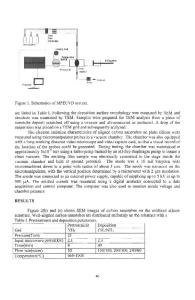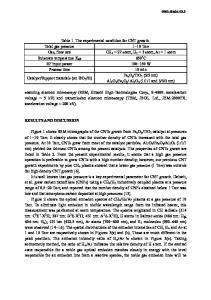Atmospheric Pressure Microwave Plasma Enhanced Coating of Carbon Nanotube Ribbons
- PDF / 994,008 Bytes
- 6 Pages / 612 x 792 pts (letter) Page_size
- 105 Downloads / 400 Views
ATMOSPHERIC PRESSURE MICROWAVE PLASMA ENHANCED COATING OF CARBON NANOTUBE RIBBONS Rutvij Kotecha1, A. Davison Gilpin1, Chaminda Jayasinghe1, Mark Schulz2,3 and Vesselin Shanov1,3 1
Materials Engineering, School of Energy, Environment, Biological & Medical Engineering (SEEBME), University of Cincinnati, Cincinnati, OH, USA 45221 2 Mechanical Engineering Department, University of Cincinnati, Cincinnati, OH, USA 45221 3 Co-director Nanoworld Lab, University of Cincinnati ABSTRACT CNT arrays were synthesized by Chemical Vapor Deposition (CVD) and spun into ribbons, which were coated using Atmospheric Pressure Microwave Plasma system. Time-ofFlight Secondary Ion Mass Spectrometry (TOF-SIMS) characterization of CNT ribbons indicated the presence of polymer films with CF2 as a repeat unit. Atomic concentration of C, F and O in the coated films was estimated from X-ray Photoelectron Spectroscopy (XPS) data. Types of bonding between the elements in the coated films was studied by curve fitting of C 1s XPS spectra. INTRODUCTION The objective of the present work is to establish optimal coating conditions for fluoropolymer films on carbon nanotubes ribbons and to characterize the polymer deposit using XPS and TOF-SIMS. Applying fluoropolymer films on CNT ribbons will enable superior mechanical properties of these materials, which can open new high tech applications such as electronic textiles, ballistic protection fabrics, tissue engineering etc [1]. In order to improve the handleability and mechanical properties of CNT threads, coating is indispensable. The explored approach for coating CNT ribbons is novel since it is based on atmospheric pressure microwave plasma system. This eliminates the necessity for enclosing materials in a vacuum chamber and simplifies the coating technique. EXPERIMENT Spinnable carbon nanotubes (CNT) were synthesized by Chemical Vapor Deposition (CVD) in a reactor manufactured by First Nano (CVD Equipment Corp.). Ethylene was cracked in the presence of Ar, H2 and water vapor in the reactor. CNT were grown at 750°C on silicon substrates pre-coated with Fe based catalyst. CNT were pulled from one end of the CNT array and wound on a PTFE belt thus forming a ribbon. Figure 1 (a) shows CNT ribbon being spun from CNT arrays and figure 1 (b) displays SEM image of the ribbon at 1000X.
a
b
Figure 1 (a) ribbon being spun from CNT arrays at UC Nanoworld, (b) uncoated CNT ribbon as observed in SEM at 1000X magnification The CNT ribbons were coated using Atmospheric Pressure Microwave Plasma system, manufactured by ASTeX Corporation (a subsidiary of MKS Instruments, Inc.). Microwave plasma systems use microwave resonance cavity as described in [2]. As the plasma gas flows through the quartz torch, it interacts with microwaves in the presence of a ceramic rod and plasma is generated [3]. The plasma gas used for deposition of thin films consisted of a mixture of 99% He and 1% H2 or only He. The flow rate of plasma gas varied from 2 Lpm to 5 Lpm. Perfluoroheptane (mixed isomers, 98% purity; abbreviated as PFH) w
Data Loading...










